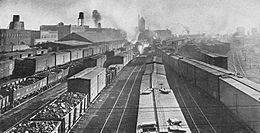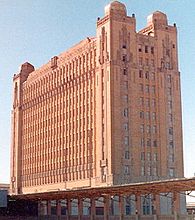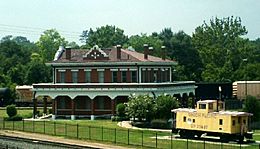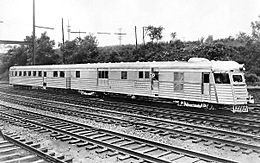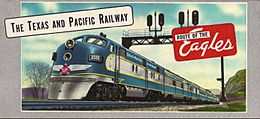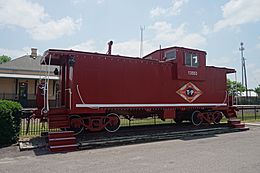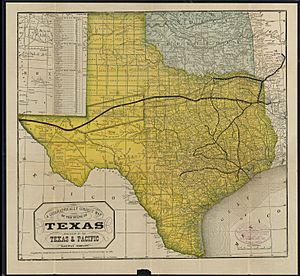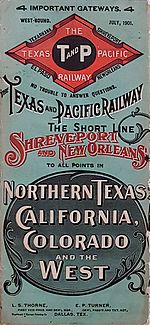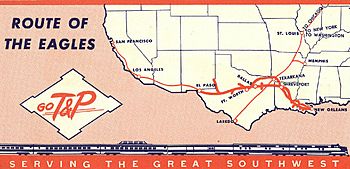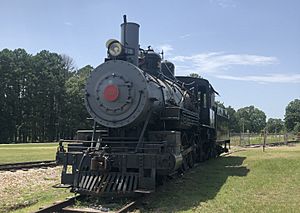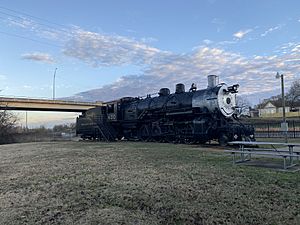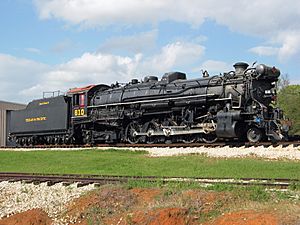Texas and Pacific Railway facts for kids
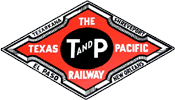 |
|
| Overview | |
|---|---|
| Headquarters | Marshall, Texas |
| Reporting mark | TP |
| Locale | Texas, Louisiana, Oklahoma, and Arkansas |
| Dates of operation | 1871–1976 |
| Successor | Missouri Pacific |
| Technical | |
| Track gauge | 4 ft 8 1⁄2 in (1,435 mm) standard gauge |
The Texas and Pacific Railway Company, often called the T&P, was a big railroad company in the United States. It started in 1871 with a special permission from the government. Its main goal was to build a railroad line that would stretch across the southern part of the country, connecting Marshall, Texas, all the way to San Diego, California.
Contents
The T&P Railway Story
The T&P quickly became important in Texas by the mid-1870s. Building the railroad west was tough and slow. But then, a rich businessman named Jay Gould became interested in the railroad in 1879.
The T&P never quite made it to San Diego. Instead, it met another big railroad, the Southern Pacific, in Sierra Blanca, Texas, in 1881.
Joining Other Railroads
The Missouri Pacific Railroad, which was also owned by Jay Gould, rented the T&P from 1881 to 1885. They kept working together even after the rental ended. Missouri Pacific eventually bought most of the T&P's stock in 1928. However, the T&P kept running as its own company until October 15, 1976. That's when it officially joined with the Missouri Pacific.
Later, on January 8, 1980, the Missouri Pacific Railroad was bought by the Union Pacific Railroad. Because of some legal issues, this big merger wasn't fully approved until September 13, 1982. The actual joining with Union Pacific happened on January 1, 1997.
T&P Buildings Today
You can still see reminders of the Texas and Pacific Railway today. Two tall buildings in Fort Worth, Texas, stand out on the southern side of the city's skyline. These are the original T&P station and its office tower, plus a large warehouse next to it.
In 2001, the old passenger platforms at the T&P station were used again. They became the last stop for the Trinity Railway Express. This is a commuter train line that connects Fort Worth and Dallas. The T&P Warehouse is still there but empty. The old passenger terminal and offices have been turned into fancy apartments.
-
Silver Slipper at the Budd factory, 1933
Famous T&P Passenger Trains
The Texas and Pacific Railway ran several well-known passenger trains. Some parts of these routes, especially between St. Louis and Texarkana, were operated by the Missouri Pacific Railroad.
Here are some of their famous trains:
- Louisiana Eagle — Traveled between New Orleans, Dallas, and Fort Worth.
- Southerner — Connected St. Louis, Memphis, Tennessee, and Alexandria, Louisiana to El Paso.
- Sunshine Special — Ran from St. Louis to El Paso and Laredo, Texas.
- Texan — Went from St. Louis to San Antonio and Houston.
- Texas Eagle — A very popular train from St. Louis to various places in Texas. It had connections to Los Angeles, Mexico City, and Houston.
- Westerner — Traveled from St. Louis through Dallas to El Paso. It connected to Southern Pacific service for Los Angeles.
T&P Railway Timeline
- March 3, 1871 - The United States Congress gave a special permission, called a charter, to the Texas Pacific Railroad Company.
- 1871 - The Texas government also gave the company permission to buy two other railway companies.
- March 21, 1872 - The Southern Pacific (a different one from the big railroad mentioned earlier) was bought.
- March 30, 1872 - The Southern Trans-Continental Railway Company was purchased.
- 1872 - Thomas A. Scott, who was president of the Pennsylvania Railroad, became the president of the Texas & Pacific.
- May 2, 1872 - A law from Congress changed the company's name to Texas and Pacific Railway Company.
- June 12, 1873 - The Memphis, El Paso and Pacific Railroad Company was bought.
- July 1, 1873 - The first rail line opened between Longview, Texas, and Dallas, Texas.
- December 28, 1873 - The rail line from Marshall, Texas, to Texarkana, Texas, started service.
- 1881 - Abilene, Texas, was connected to the T&P line.
- 1888 - The T&P went bankrupt because of floods and bad crops. The land they had was then put into a separate company called the Texas Pacific Land Trust.
- 1925 - Lima Locomotive Works built special "Texas" type locomotives for the T&P. These were called "Texas" because of the T&P.
- October 15, 1976 - The T&P officially joined with the Missouri Pacific Railroad.
Legal Challenges
The Texas and Pacific couldn't get enough money to build its railroad all the way to San Diego. Because of this, the Southern Pacific was able to build its own line from California to Sierra Blanca, Texas. The Southern Pacific even used land that the Texas and Pacific had planned to use.
This led to lawsuits between the two companies. They eventually agreed to share tracks and work together on new lines. However, many of the benefits for the Texas and Pacific were later taken away by new laws.
Track Width
At first, the Texas and Pacific Railway was going to use a track width of 3 ft 6 in (1,067 mm). But the state government passed a law that required them to use the standard American track width, which is 4 ft 8 1⁄2 in (1,435 mm) gauge.
Land Given to the Railroad
From 1873 to 1881, the Texas and Pacific built 972 miles (1,560 km) of track. Because of this, they were supposed to receive huge amounts of land, over 12 million acres. However, the T&P only received land for the track built east of Fort Worth. This meant they only got about 5 million acres.
The State of Texas said the T&P didn't finish building the track on time. The state's Attorney General, Charles A. Culberson, even sued to get some land back. In the end, the state got back about 256,046 acres. This left the T&P with about 4.9 million acres, which is roughly 7,683 square miles. To compare, the state of Connecticut is about 5,543 square miles.
Surviving Steam Locomotives
Some of the powerful steam locomotives that once pulled trains for the Texas and Pacific Railway still exist today!
| Number | Built Date | Builder | Class | Wheel Type | Notes | Photo |
|---|---|---|---|---|---|---|
| 316 | 1901 | Cooke Locomotive Works | D-9 | 4-6-0 | This locomotive was sold in 1949 and later given to Abilene, Texas, in 1951. In 1974, it was donated to the Texas State Railroad and renumbered 201. It stopped running in 2013 and is now on display, waiting to be possibly fixed up. | |
| 400 | 1915 | Baldwin Locomotive Works | E-4A1 | 2-8-2 | This train was originally Fort Worth and Denver City Railway 410. The T&P bought it in 1958 to help with freight trains during floods. It broke down and was given to Marshall, Texas, in 1963. Sadly, it was damaged by vandals. In 2008, it moved to the Texas and Pacific Railway Museum for display and was fixed up to look nice again. | |
| 610 | 1927 | Lima Locomotive Works | I-1a | 2-10-4 | This locomotive was given to Fort Worth, Texas, in 1951. In 1975, it was chosen to pull the American Freedom Train! It was repaired and ran the Freedom Train through Texas in 1976. After that, the Southern Railway rented it for special trips. In 1981, it came back to Texas. Since 1982, it has been on display at the Texas State Railroad. |
Texas Pacific Land Trust
The Texas Pacific Land Trust (NYSE: TPL) was created in 1888. This happened after the T&P railway went bankrupt. The Trust's job was to sell off the railway's land in an organized way. At that time, it received over 3.5 million acres of land.
As of 2006, the Trust was still the largest private landowner in Texas. It owned about 966,392 acres across 20 counties in the western part of the state. The Trust also makes money from oil and gas found on some of its land.



